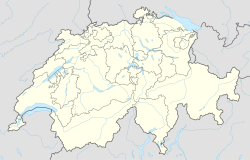Meggen
| Meggen | ||
|---|---|---|
 |
||
|
||
| Coordinates: 47°3′N 8°22′E / 47.050°N 8.367°ECoordinates: 47°3′N 8°22′E / 47.050°N 8.367°E | ||
| Country | Switzerland | |
| Canton | Lucerne | |
| District | Lucerne | |
| Government | ||
| • Mayor |
Gemeindepräsident Urs Brücker GLP (as of 2016) |
|
| Area | ||
| • Total | 7.28 km2 (2.81 sq mi) | |
| Elevation | 479 m (1,572 ft) | |
| Population (Dec 2015) | ||
| • Total | 6,853 | |
| • Density | 940/km2 (2,400/sq mi) | |
| Postal code | 6045 | |
| SFOS number | 1063 | |
| Surrounded by | Adligenswil, Greppen, Horw, Küssnacht (SZ), Lucerne (Luzern), Stansstad (NW), Weggis | |
| Website |
www Profile (German), SFSO statistics |
|
Meggen is a municipality in the district of Lucerne in the canton of Lucerne in Switzerland.
Meggen is first mentioned in 1226 as Meken, though a 14th Century copy of an older document mentions in Acta Murensia around 1160.
Meggen has an area of 7.3 km2 (2.8 sq mi). Of this area, 47.6% is used for agricultural purposes, while 23.7% is forested. Of the rest of the land, 28.5% is settled (buildings or roads) and the remainder (0.3%) is non-productive (rivers, glaciers or mountains). In the 1997 land survey[update], 23.69% of the total land area was forested. Of the agricultural land, 41.6% is used for farming or pastures, while 6.06% is used for orchards or vine crops. Of the settled areas, 20.25% is covered with buildings, 0.41% is industrial, 0.69% is classed as special developments, 1.79% is parks or greenbelts and 5.37% is transportation infrastructure. Of the unproductive areas, and 0.14% is other unproductive land.
The municipality is located on the Küssnacht arm of the Lake of Lucerne. In 1897 it was the end station of the Gotthardbahn.
Meggen has a population (as of 31 December 2015) of 6,853. As of 2007[update], 10.6% of the population was made up of foreign nationals. Over the last 10 years the population has grown at a rate of 10.4%. Most of the population (as of 2000[update]) speaks German (93.3%), with English being second most common ( 1.6%) and Italian being third ( 1.0%).
In the 2007 election the most popular party was the FDP which received 33.1% of the vote. The next three most popular parties were the SVP (24.8%), the CVP (21.8%) and the SPS (10.3%).
...
Wikipedia



